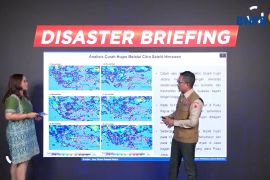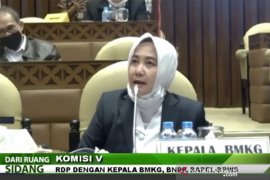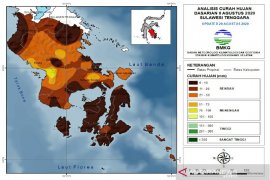As it battles the coronavirus pandemic, Indonesia, which is currently entering the dry season, is bracing for a possible prolonged drought.
The Meteorology, Climatology, and Geophysics Agency (BMKG) has forecast that 30 percent of the country’s regions entering the dry season in the next three months will experience drier-than-usual weather conditions.
This year, the dry season started in April, and is forecast to be dominant in May, June, and July, and peak during the period from August to September.
The hydrological drought is forecast to chiefly impact 10 provinces -- West Java, Central Java, Yogyakarta, East Java, South Sulawesi, Bali, West Nusa Tenggara (NTB), East Nusa Tenggara (NTT), Maluku, and Papua -- with affected areas spread across 90 districts and cities.
Agricultural land forecast to be affected by drought in the 10 provinces cover 1.14 million hectares of irrigation areas.
"Hence, steps to mitigate the impact must be thoroughly prepared, so that the stability of food prices is not affected," President Joko Widodo (Jokowi) said at the Merdeka Palace, Jakarta, on May 5, 2020, while chairing a virtual limited meeting on "Anticipating the Impact of Drought on the Availability of Staple Food". The meeting was attended byVice President Ma'ruf Amin and ministers.
The impact of COVID-19 and a prolonged drought could deal a double blow to the country by prompting a food crisis, if the problems are not anticipated and managed properly.
To prevent a food shortage, the government has outlined two strategies: encouraging planting of crops earlier, before the 2020 dry season sets in; and, delivering the necessary infrastructure and facilities promptly to support the planting process.
"The planting season should be accelerated. We must capitalize on the rainfall that still exists today. We must ensure that farmers continue to produce and plant by applying health protocols," Jokowi remarked.
The Agriculture Ministry is implementing the Paddy Planting Acceleration Movement in several regions to encourage early planting.
Coordinating Minister for Economic Affairs Airlangga Hartarto had earlier announced that the government will offer incentives worth Rp600 thousand to 2.44 million farmers to facilitate planting in the next period.
Furthermore, the Public Works and Public Housing (PUPR) Ministry has readied several dams, reservoirs, water retention basins, bore wells, and other facilities to store water, particularly for irrigation purposes.
PUPR Minister Basuki Hadimuljono has highlighted President Joko Widodo's instructions that the government needs to guarantee water supply for food, health, and basic services during the COVID-19 pandemic.
Field monitoring results have indicated that 241 reservoirs cover 16 main reservoirs holding 4,721 billion cubic meters of water for irrigation areas spanning 512,515 hectares, or 96.57 percent of the total 530,738 hectares.
Of the 16 main reservoirs, 10 reservoirs have normal water levels — Jatiluhur, Cirata, Saguling, Batutegi, Sutami, Wonorejo, Bili-Bili, Kalola, Way Rarem, and Ponre-Ponre.
Meanwhile, six reservoirs hold below-normal levels of water — Kedungombo, Wonogiri, Wadas Lintang, Cacaban, Selorejo, and Batu Bulan.
In addition to the dams, the PUPR Ministry is monitoring water availability in 4,227 retention basins and 344 weirs, with a capacity of 338.8 cubic meters.
Moreover, the ministry has readied 7,914 bore wells by utilizing an irrigation network of groundwater and raw water, spanning an area of 118,652 hectares, and groundwater for raw water of 2,386 cubic meters per second. Of the total, 4,098 bore wells are functioning normally, while operational disruptions are being encountered in the remaining 3,816 bore wells.
Of the 4,098 normally functioning bore wells, 488 are located in Sumatra, while 46 wells are in Kalimantan, 701 in Sulawesi, 1,514 in Java, 1,190 in Bali-Nusa Tenggara, 2 in Maluku, and 148 wells in Papua.
In the meantime, Yanto, Ph.D, a hydrological and water resources expert at the Jenderal Soedirman University, has highlighted the criticality of maintaining water supply as one of the key ways to achieving food resilience.
He has stressed on the importance of constructing infrastructure to collect and store rainwater, both on a small and large scale.
"The government has planned to build 65 reservoirs by 2030 that can boost the capacity of reservoirs to 19.1 billion cubic meters," he remarked.
However, the hydrologist said, it is necessary to take into account the projected population growth rate for Indonesia for 2030. In future, more dams will be needed to maintain water availability, he said.
Furthermore, he stressed on giving unwavering attention to efficient management of water resources. This would require utilizing information and computing technology to support optimal management of data on water resources, he remarked.
Usually, drought in Indonesia not only causes water and food crises, but also triggers forest fires, particularly in peatland areas.
Hence, coinciding with the Idul Fitri Islamic festivities on May 24 this year, the authorities have resorted to climate engineering by using Weather Modification Technology (TMC) over peatland areas in Riau Province to prevent wild fires.
Rains are critical to ensuring that peatland areas remain wet and water levels at canals and reservoirs are sufficient.
"The team has continued to work on holidays by undertaking one flight sortie. Cloud seeding has been conducted in Bengkalis, Siak, and Meranti Islands using 800 kilograms of NaCl, or salt," director of Forest and Land Fire Control at the Ministry of Environmental Affairs and Forestry (KLHK), Basar Manullang, noted in a statement on May 25, 2020.
Efforts to produce rains were carried out by the Ministry of Environmental Affairs and Forestry, in cooperation with the Agency for the Assessment and Application of Technology (BPPT), the Indonesian Air Force, and other partners.
Since the commencement of weather modification operations (from May 13 to May 24, 2020), 10 flight sorties have been conducted, with a total of 8 tons of sodium chloride (NaCl), or salt, used for cloud seeding in Riau Province.
The weather modification activities have succeeded in inducing rains in the cities of Pekanbaru, Siak, Kuala Kampar, Sei Pakning, Kandis, and Sedingin.
"Since the start of the weather engineering operation through TMC from May 14 to May 24, 2020, the total cumulative volume of rainwater has been estimated to reach 33.1 million cubic meters," Basar remarked.
The KLHK has prioritized rain engineering at various locations in provinces prone to forest and land fires, such as Riau, Jambi, and South Sumatra.
Located on the equatorial line, and between Asia and Australia, Indonesia has only two seasons -- rainy and dry. The dry season usually extends between April and September, while the rainy season lasts from September to March.
Hydro-meteorological disasters have, over the years, dominated the list of natural disasters in Indonesia, which is often flooded during the rainy season and experiences very dry conditions in certain regions during the dry season.
Last year, a state of emergency was declared in 55 districts and municipal administrations in seven provinces over prolonged drought.
Related news: Rice plantation sooner as precaution against food crisis amid pandemic
Related news: Ensuring water availability important for realizing food resilience
Editor: Rahmad Nasution
Copyright © ANTARA 2020












